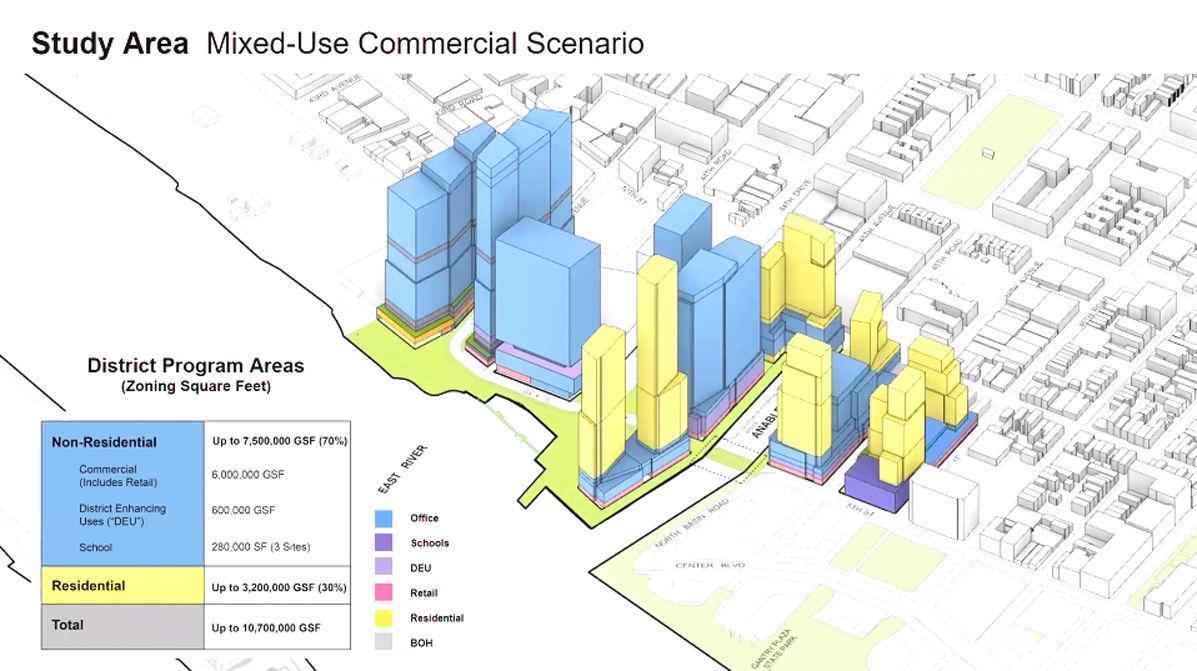 Posted Jul 7, 2020, 3:31 PM
Posted Jul 7, 2020, 3:31 PM
|
 |
New Yorker for life
|
|
Join Date: Jul 2001
Location: Borough of Jersey
Posts: 51,919
|
|
https://www.qchron.com/editions/quee...b1df3fad6.html
Density, affordable housing top LIC talk
Your LIC envisions dense but mixed use when Anable Basin is rebuilt

by Michael Gannon, Editor
Jul 2, 2020
Quote:
The fifth community meeting hosted by those seeking to redevelop the Long Island City Waterfront in and around Anable Basin was geared toward discussing building and population density, and just how to strike the right balance building heights, percentages of housing, business and public space to keep and attract residents and jobs.
But many of the public’s thoughts and questions came down to affordable housing, and just what the definition of that would be.
Nearly 200 people joined the Zoom discussion hosted Tuesday by Your LIC, the consortium made up of Simon Baron Development, MAG Partners, TF Cornerstone and Plaxall, which collectively own or manage the 28 acres in the redevelopment plan.
|
Quote:
They joined forces at the city’s behest after Amazon pulled out of a $27 billion agreement to expand into Queens due to political opposition in February 2019.
One rendering offered a color-coded projection of buildings that would set aside 3.2 million square feet for residential use, or 30 percent. A second showed buildings from 295 feet to 730 feet in height.
“Density is misunderstood,” said Gregg Pasquarelli of SHoP Architects. “It’s about supply and demand. It creates the revenues used to pay for schools, hospitals and parks.”
He also said it makes communities more resistant to the recent economic and pandemic-related upheavals, and results in less displacement than communities with more height regulations and zoning restrictions.
“Density increases opportunities,” he said. “[It] supports mass transit and infrastructure. It creates a demand for public space but also the market.”
|
Quote:
Rebecca Karp of Karp Strategies said with the proper planning, a mixed-use community can bring in an eclectic mix of businesses and create jobs for residents of various skill levels, which she said also fosters parks, hotels, restaurants and other uses.
“They’re certainly not gated office parks,” Karp said of similar developments in major cities in recent years in places such as Boston, San Francisco and London. “They are integrated into the neighborhoods.”
Going into breakout groups, several attendees on the conference call had concerns. Spencer Heckwolf said a lot has changed since the earlier meetings in pre-COVID-19 times, lending itself to greater emphasis on housing.
“New York presently has a housing shortage, not a jobs shortage,” he said. “There’s uncertainty over how office space will be used. You can live and work from home. You can just work at the office.”
As for affordable housing, Maeve Ives, a vice president at Simon Baron, said 25 percent of the proposed 5,700 housing units — about 1,400 — would be affordable under the city’s mandatory inclusionary housing regulations.
But she also said definitions and dollar figures would be based on area median income levels as stipulated by the federal government.
“That would have to be figured out through the [uniform land use review procedure] process,” she said.
One resident said that gives him a major cause for concern.
“You mentioned Hudson Yards,” he said. “Most of the jobs in Hudson Yards are retail. No retail worker in Hudson Yards can afford an apartment there.”
|
Quote:
A participant named Ryan, who said he is a light manufacturer in LIC, said his vendors and retail in general are already being priced out.
“I don’t think these apartments will be affordable for anyone making less than $70,000 a year,” he said.
A handful of residents expressed fears over building up in an area that already has flooding problems and is subject to storm surges in events such as hurricanes Sand and Irene in the last decade.
But Pasquarelli and Dana Getman, also of SHoP Architects, both said in separate sessions that the plans call for designing the waterfront itself, the slope and composition of the land and green spaces and modern technology to protect not only any new development but its neighbors.
“It would act as a buffer for the neighborhoods to the east of the site,” Getman said.
Addressing another environmental concern raised earlier in the meeting, Pasquarelli said taller buildings — and the green technology they intend to employ — leave a smaller carbon footprint.
|
__________________
NEW YORK is Back!
“Office buildings are our factories – whether for tech, creative or traditional industries we must continue to grow our modern factories to create new jobs,” said United States Senator Chuck Schumer.
|